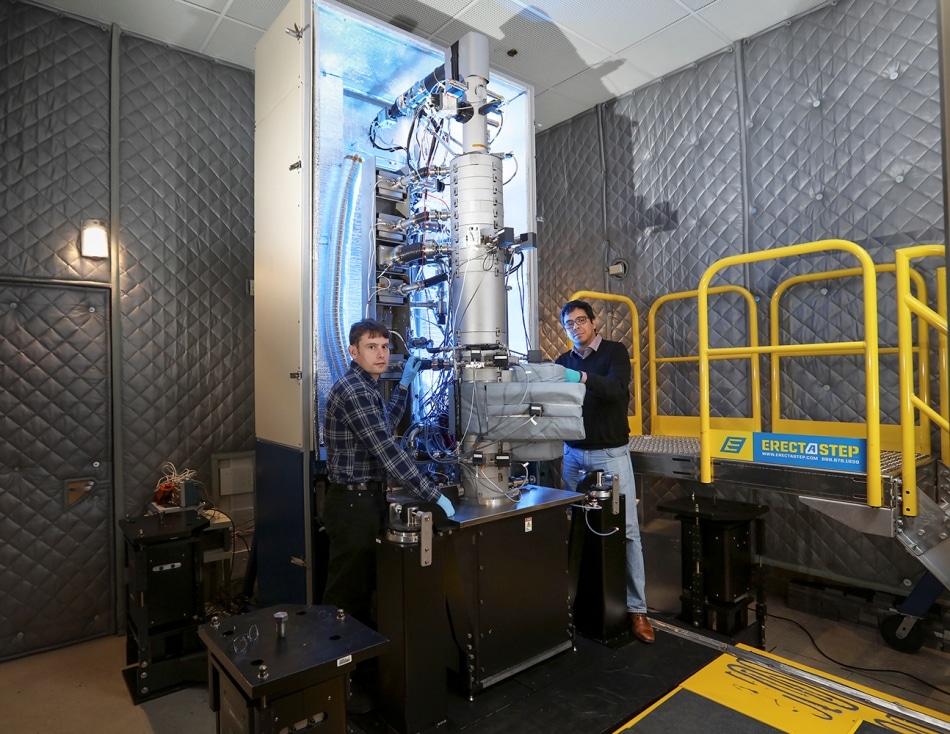Mar 14 2018
A group of researchers headed by the Department of Energy’s Oak Ridge National Laboratory has discovered an innovative method to find out the local temperature of a material from an area with a width of just one-billionth of 1 m, or roughly 100,000 times thinner than a strand of human hair.
 From left, Andrew Lupini and Juan Carlos Idrobo use ORNL’s new monochromated, aberration-corrected scanning transmission electron microscope, a Nion HERMES to take the temperatures of materials at the nanoscale. (Image credit: Oak Ridge National Laboratory, U.S. Dept. of Energy; photographer Jason Richards)
From left, Andrew Lupini and Juan Carlos Idrobo use ORNL’s new monochromated, aberration-corrected scanning transmission electron microscope, a Nion HERMES to take the temperatures of materials at the nanoscale. (Image credit: Oak Ridge National Laboratory, U.S. Dept. of Energy; photographer Jason Richards)
This finding has been reported in the Physical Review Letters journal, and it assures to enhance knowledge of practical but atypical chemical and physical properties that appear in structures and materials at the nanoscale. The potential to find out nanoscale temperatures can assist in revolutionizing semiconducting materials, microelectronic devices, and other technologies, whose advancement is reliant on delineating the atomic-scale vibrations that occur due to heat.
The researchers adopted a method known as electron energy gain spectroscopy in a newly procured, specialized instrument that generates images by using both great spectral and high spatial resolution detail. The instrument, with a height of 13 feet and fabricated by Nion Co., is known as HERMES, an acronym for High Energy Resolution Monochromated Electron energy-loss spectroscopy-Scanning transmission electron microscope.
It is a known fact that atoms are always dynamic. An increase in temperature increases their dynamics. In this study, the researchers adopted the new HERMES instrument to evaluate the temperature of semiconducting hexagonal boron nitride through direct observation of the atomic vibrations corresponding to heat inside the material. Collaborators from Nion, the developer of HERMES, and Protochips, the developer of a heating chip used in the experiment, also took part in the study.
“What is most important about this ‘thermometer’ that we have developed is that temperature calibration is not needed,” stated physicist Juan Carlos Idrobo from the Center for Nanophase Materials Sciences, a DOE Office of Science User Facility at ORNL.
Other thermometers mandate advance calibration. For instance, to form temperature graduation marks on a mercury thermometer, the manufacturer must have an understanding of the amount of mercury that expands as a result of an increase in temperature.
“ORNL’s HERMES instead gives a direct measurement of temperature at the nanoscale,” stated Andrew Lupini from ORNL’s Materials Science and Technology Division. The experimenter has to have the knowledge of merely the intensity and energy of an atomic vibration in a material, where both are evaluated at the time of the experiment.
These two attributes are represented as peaks used to compute the ratio of energy loss and energy gain. “From this, we get a temperature,” elucidated Lupini. “We don’t need to know anything about the material beforehand to measure temperature.”
In one of the 1966 volumes of Physical Review Letters, H. Boersch, J. Geiger, and W. Stickel reported a validation of electron energy gain spectroscopy (at a higher length scale) and indicated that the evaluation must rely on the sample’s temperature. Depending on that hypothesis, the ORNL researchers proposed that the temperature of a nanomaterial has to be measurable upon using an electron microscope with a filtered or “monochromated” electron beam, to choose energies inside a narrow range.
In order to conduct electron energy loss and gain spectroscopy experiments, researchers positioned a sample material inside the electron microscope. The electron beam in microscope passes through the sample, where a major portion of electrons hardly interacts with the sample. In the case of electron energy loss spectroscopy, after passing through the sample, the electron beam loses its energy. In contrast, in the case of energy gain spectroscopy, upon interaction with the sample, the electrons gain energy.
The new HERMES lets us look at very tiny energy losses and even very small amounts of energy gain by the sample, which are even harder to observe because they are less likely to happen,” stated Idrobo. “The key to our experiment is that statistical physical principles tell us that it is more likely to observe energy gain when the sample is heated. That is precisely what allowed us to measure the temperature of the boron nitride. The monochromated electron microscope enables this from nanoscale volumes. The ability to probe such exquisite physical phenomena at these tiny scales is why ORNL purchased the HERMES.
ORNL researchers are continuously enhancing the potentials of electron microscopes to enable innovative techniques of carrying out forefront research. Upon being questioned “Wouldn’t it be fun to try electron energy gain spectroscopy?” by the Nion electron microscope developer Ondrej Krivanek, Idrobo and Lupini made the most of the opportunity to be the first to investigate this potential of their HERMES instrument.
Nanoscale resolution enables characterization of the local temperature at the time of phase transitions in materials, which is highly impossible by adopting methods that do not possess the spatial resolution of HERMES spectroscopy. For instance, an infrared camera is restricted by the wavelength of infrared light to considerably huge objects.
Although in this study the researchers investigated nanoscale environments from ambient temperature to nearly 1300 °C or 2372 °F, the HERMES can be adopted for investigating devices that function across a broad array of temperatures, for instance, electronics that function under room temperatures and conditions to vehicle catalysts that function over 300 °C, or 600 °F.
The title of the study is “Temperature Measurement by a Nanoscale Electron Probe Using Energy Gain and Loss Spectroscopy.”
The Department of Energy Office of Science funded the study.